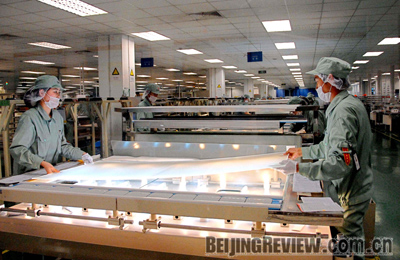|

A HELPING HAND: The government is urging commercial banks to issue loans to
small and medium-sized enterprises, such as Suntech Power Co. of Wuxi City (pictured),
which provide a huge number of employment opportunities
The People's Bank of China announced on September 15 that it was cutting the benchmark one-year loan interest rate, the first time in four years. It also said it would slash the reserve requirement ratio-the amount of money lenders must keep with the central bank-for the first time in nine years.
The central bank cut the one-year lending rate by 0.27 of a percentage point to 7.20 percent, effective on September 16, while interest rates for deposits remain unchanged. It will cut the reserve requirement ratio for financial institutions by 1 percentage point to 16.5 percent on September 25 for all banks, including the Postal Savings Bank, except the five largest ones-the Industrial and Commercial Bank of China, the Agricultural Bank of China, the Bank of China, the China Construction Bank and the Bank of Communications. It also will allow locally incorporated financial institutions to cut their reserve requirement ratios by 2 percentage points.
Analysts said the rate cut indicated the central bank is starting to loosen its control over credit in contrast with the stringent monetary policy it adopted a year ago. But there had been earlier indications that the central bank would eventually reverse course. On August 4, it agreed to let nationwide commercial banks lend 5 percent more than their previous credit quotas and local commercial banks lend up to 10 percent of their loan quotas. Shortly afterward, the central bank loosened credit controls on foreign banks and allowed them to increase their renminbi loan quotas up by 15 percent this year.
Ba Shusong, a financial researcher at the State Council Development Research Center, said in an interview with the Chinese news website People.com that the central bank's current credit loosening policy was a mild adjustment for the time being. The primary goal is to prevent a rapid economic slowdown from occurring. But Ba added that the credit readjustment policy should not be seen as a turning point in China's macro-control policy.
Lian Ping, chief economist at the Bank of Communications, said in his research report that the central bank should not abandon its stringent monetary policy, because the domestic economy is still challenged by inflationary pressure, excessive liquidity and the possible rebound of investment credit. But considering the new policy change, the central bank might make further slight changes to its monetary policy in line with the country's future economic development, he said.
Financing enterprises
The central bank urged commercial banks to issue more loans to help finance small and medium-sized enterprises (SMEs), farmers and agriculture-related sectors, energy-conservation and emission-reduction projects and post-earthquake reconstruction efforts. At a news conference on September 7, the Chinese Banking Regulatory Commission said commercial banks could grant more loans to firms working in the above-mentioned sectors.
| 